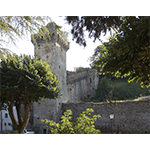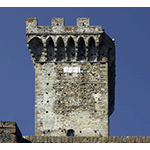Fortified system of Vicopisano
Conquered by the Florentines in 1406, the Castle of Vicopisano represented an important strategic-military point, being situated near the course of the Arno which, up to the middle of the 16th century, that is, up to the hydraulic works ordered by Cosimo I and Francesco I de' Medici, passed between Calcinaia and Bientina. The castle was thus situated on the boundary line between Pisa and Lucca, and as such, of decisive importance for the control of river trade. For this reason the Republic of Pisa had been especially attentive, since the 13th century, to the defensive system of the town, which, in fact, resisted numerous attacks from Lucca. It was only in 1406 that the Florentines, after 8 months of siege, managed to overcome Pisan resistance, thanks also the support, it is said, of ships that bombarded Vicopisano from the Arno. But the conquerors did not leave the town to decline, but provided instead for fortifying it still further, using as consultant one of the greatest architects of the time, Filippo Brunelleschi, renowned also as military engineer. The technical model elaborated by Brunelleschi in 1435 did not differ from the military models of the time, based substantially on elements of medieval military technology. However, the geometric perfection of the layout and the play of proportions among the individual parts brought the role of geometry into the foreground - the great theme of art-science of Brunelleschi and of fifteenth-century humanist culture - as a "weapon" of defence.
The Rocca consisted of a donjon standing at the highest point of the town, from which ran a wall connecting it to the Selvatici Tower. The whole was surrounded by an imposing circle of walls with a walkway all around the top and with square and semicircular towers along it. Lost and then conquered again by Florence, the Rocca was first abandoned and then bought by private individuals. After recent restoration, the defence system that surrounds the picturesque town is today fully available as a tourist-cultural attraction.
****************************
Texts by Elena Fani
English translation by Catherine Frost
Last update 08/feb/2008





